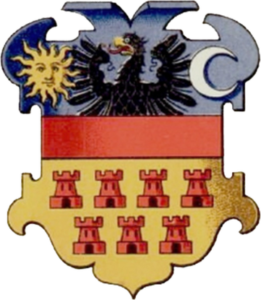Szászalmád

Szászalmád (Német-Almás, Alma Vii, Alma Săsească, Almen, Königsboden) can be found in Transylvania, Romania, and it is famous for its huge Saxon fortified church. It belongs to the village of Muzsna which is 8 km to the southeast of it. The town of Medgyes (Medias, Mediasch) is 18 km to the southeast, too.

It was a village of the Transylvanian Saxons for many centuries and belonged to the Kingdom of Hungary, the Principality of Transylvania, and Austria respectively for a long time. You can find it on the map:

Originally, the reason for the arrival of the Saxons was the next: around 1150, King Géza II of Hungary called them in to protect the Southern Carpathians against invading Besenyő (Pecheneg) tribes. Before them, the Székely border guard settlements guarded those sparsely populated areas. They were moved to other lands. The Saxons sailed down the Danube and arrived in Transylvania on carts. Upon settlement, they were given partly inhabited and partly forested /irrigated/ areas.

You can read more about the Transylvanian German Saxon people here:
https://www.hungarianottomanwars.com/essays/who-were-the-german-saxons-in-transylvania/

The fortified church
On a small hill above the village stands a huge Saxon fortress church, with a 16th-century fortress wall supported by rectangular towers. The fortified church was built at the end of the 15th century, and it has been preserved fairly unchanged. The ring walls surround an irregular area and are adapted to the ground conditions. The ring wall is reinforced by 4 towers.

The southern part of the ring connects to the outer edge of the west tower and the east tower and enlarges the churchyard to the south. Flanking the west tower, the wall jumps forward like a knee and then goes towards the bell tower in the south to join it.

The bell tower is located to the south of the church. It is a square, five-story fortification tower in the circular wall of the church castle. The ground floor has an embankment. The first floor with small windows and a built-in chimney was habitable. On the third floor, there are small projecting oriels at the corners, each with 3 combined embrasures. Today these corner niches are all bricked up.

The fortified church was built at the beginning of the 14th century as a towerless Gothic hall church made of sandstone.
At the beginning of the 16th century, a redoubt was built over the choir, a last refuge for the defenders of the castle (defense story with embrasures). The date inscribed on the old star-net vault of the hall may be considered the year of completion of this fortification. The altar was built in 1582. In the center is a large, unartistic figure of Christ on a pedestal with Christian symbols. Under the pedestal on the first step of the altar is a verse and the year 1582.

Regarding the bells of the church: A valuable bell is the middle bell from the second half of the 15th century. In a minuscule script, bordered on both sides by 2 parallel lines, we read the following inscription:
“o got perot maria hilf uns aus not das ich heit pegin das ist ein guet”.
The large bell has the inscription:
“Protestant parish of Almen Schieb and Kauntz, Hermannstadt 1926”.
The smaller bell has the inscription: “The living I call, the dead I mourn”. “1926”

The history of Szászalmád
The place name derives from the Old High German personal name Almo, which means elm; the name Ulmen can still be found in the community – it may have been founded near a stand of elms. The first document mentioning Szászalmád as “Alma” in 1289 shows that the village belonged to the Mediasch (Medgyes) church chapter.

In a document from 1356, the see court of Mediasch pronounces a death sentence on the murderer HESE von Almen – according to this, Almen (Szászalmád) was a free royal land of the municipality of the Mediasch see. In the above-mentioned document, Count Simon is mentioned who intervened in a murder case to punish the murderer.

In 1417, a legal dispute arose between the inhabitants of Almen and Count Michael over the construction of a mill. As it was, in 1417 Count Michael successfully conducted a lawsuit against the municipality of Almen. He seems to have held a privileged position in the community, as he owned the right to mill and the community could not take it away from him.

We know a lot about the life of a priest, Magister Ladislaus /1449-1465/. Ladislaus was a member of the count’s family of Alman, who had a dispute with the municipality of Almen over a mill in 1417, which was decided in favor of Almen. Ladislaus had acquired the title of master of liberal arts /”Ladislaus de Alma, artium liberalism magister”/.
To become the parish priest of Almen, he and his brother Count George promised the parish that they would give the mill owned by the Count’s family, together with a fish pond and a willow grove, in return for the election of the parish priest. Based on this promise, the people of Almen elected Magister Ladislaus as the parish priest of Almen. In 1453, together with other learned parish priests, he acted as examining magistrate when a legal dispute arose between the nobleman Nikolaus Zas and the Mediasch (Medgyes) Province of the Two Seats.

After the death of the two brothers, the parish priest Magister Ladislaus and his brother Count Georg, Georg’s widow, Barbara, resisted the takeover of the aforementioned properties by the municipality of Almen. A lawsuit ensued which was decided in 1465 in favor of Barbara by the Sibiu Province of the Seven Seats.

Since the parish belonged to the Mediasch (Medgyes) chapter, the parish priest of this place received the entire tithe in the pre-Reformation period and also for a while afterward. However, as we learn from news from 1580, the parish priest, together with the other parish priests of this chapter, leased a tithing quart, except for the tithing of foreigners and the tithing of the self-construction, to the prince and finally ceded it in 1612 through a compulsory settlement.

The parish priest received three tithes, while the prince and later the treasury received one-tenth. In addition, before the tithes were redeemed, the treasury received the entire piglet tithe. We know, that in 1510, Almen paid the same amount of tax as Arbegen. In 1513, the village had to pay taxes for a “Zahlhaus”, just like Kirtsch, Wölz, Tobsdorf, and Niemesch. At that time, Almen was one of the smallest villages in the “Two Seats” district.
In 1519, the territory of the vanished municipality of Weißdorf was divided between Almen and Meschen. In connection with this, royal judge Johann Lulay and the mayor of Szeben (Sibiu), Petrus Wolf, arrived on the spot by royal order. In 1523, King Lajos II of Hungary waived the tax for 3 years for alpine pastures and other places that had burnt down. In 1532, 57 families were listed in it.

A preserved document from 1732 shows that a farmer called Simon Mätz from Almen sold himself as a serf for life to the Medgyes (Mediasch) merchant Georg Meissner because of tax debts and illness, together with all his children and children’s children in exchange for the cancellation of the debt of 81 gulden and 55 denarii. The contract stipulated that the serf may only enter into marriage with the lord’s permission, if necessary.

In 1850, 542 inhabitants lived in the village, of whom 330 were Germans, 134 Romanians, and 78 Roma people. After the end of the First World War, it became part of Romania. The highest number of Germans (451) was counted in 1930. In 1941, the largest number of inhabitants was 682; of these, 435 were Germans. In the 1980s and 1990s, most of the Transylvanian Saxons emigrated from the village to Germany.

1960: With state support, the church and church castle were thoroughly renovated. In 2002, of the only 367 inhabitants left, 286 described themselves as Romanians, 70 as Roma, 5 as Hungarians, 4 as Ukrainians, and 2 as Germans. Today, the village is predominantly inhabited by Romanians and Roma. Apart from the numerous meetings of the German inhabitants of the village in Germany, the first meeting in Szászalmád took place in August 2017.

We have a few legends connected to Szászalmád:


Also: TEUS. Transilvania Noastră – Erdélyünk – Unser Siebenbürgen
Also: see the German, Romanian, and Hungarian pages of Wikipedia and https://alma-vii.de/phpalmen/modules.php?name=Sections&sop=viewarticle&artid=7

Dear Readers, I can only make this content available through small donations or by selling my books or T-shirts.
If you like my writings, please feel free to support me with a coffee here:
You can check out my books on Amazon or Draft2Digital, they are available in hardcover, paperback, or ebook:
https://www.amazon.com/dp/198020490X or at https://books2read.com/b/boYd81

My work can also be followed and supported on Patreon: Become a Patron!http://Become a Patron!
Here are some more pictures of Szászalmád:








































